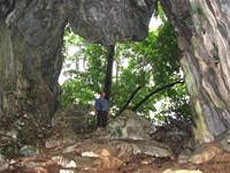More than 60 scientists have joined up with their Vietnamese colleagues to tour a number of archaeological sites in the central province of Thanh Hoa.

During the fact-finding tour on December 6 and 7, the delegation, who had attended the 19th congress of the Indo-Pacific Prehistory Association (IPPA) in Hanoi, showed a keen interest in the Dong Son Culture in Thanh Hoa at the provincial museum.
The museum is famous for its collection of tools and bronze artifacts such as drums that belonged to the Dong Son Culture where humans existed 400,000 years ago.
At Con Moong Cave, which is thought to have housed many prehistoric people, the team of scientists saw the latest research done on the cave.
The cave provided shelter to the people of three separate prehistoric cultures: the Son Vi, the Hoa Binh and the Bac Son.
The cave is special as its layers of rock hold evidence of human evolution from the Palaeolithic to the Neolithic era’s progress from hunter gathers to farmers, says Nguyen Khac Su, an associate professor at the Vietnam Archaeological Institute in Hanoi.
Recent excavations also revealed many new discoveries, including axes, ceramics, stone and bone artifacts and tombs.
Thanh Hoa is putting together a scientific study of the cave, which will be submitted to the United Nations Educational, Scientific and Cultural Organisation (UNESCO) for recognition as a world cultural heritage.
Although hearing of Vietnam’s reports on the excavation sites of the Ho Dynasty’s Nam Giao altar and Con Moong Cave at the 19th IPPA congress, the new discoveries about Thanh Hoa’s culture were unexpected, they said.
Su said that the tour will inform scientists of Thanh Hoa’s cultural potential to help them better understand Vietnam’s archaeology and win their support for these relics when they are nominated to UNESCO’s list of world cultural heritages.
The scientists will contribute their opinions on the excavation, preservation and values of these ancient relics, Su added.